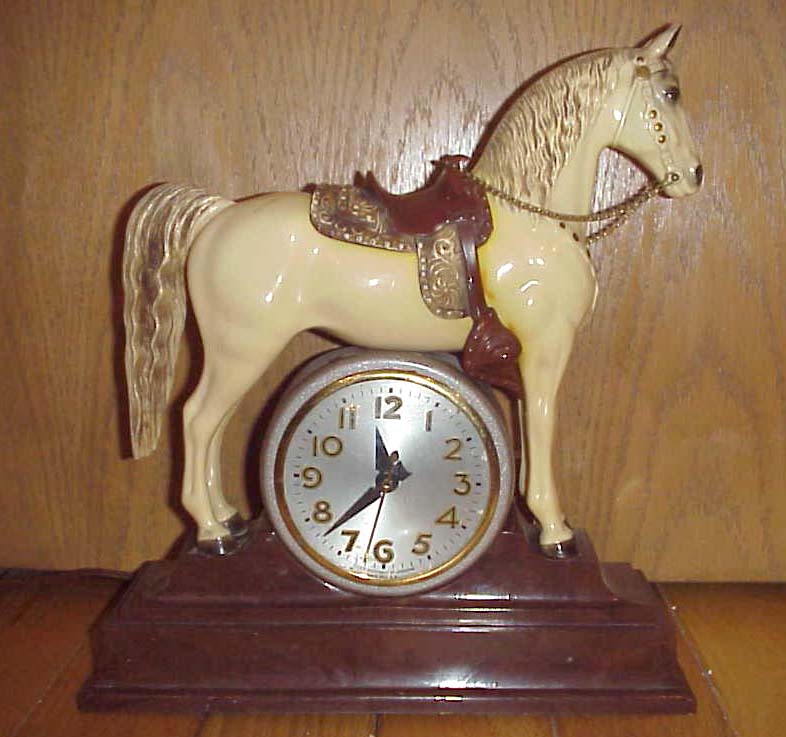
All Images and text on this site copyright Mike R. Jackson 1998-2021
Mastercrafters Horse Clocks
There are two topics regarding Hartland Plastics history that were either not well documented or incorrectly represented in some of the current literature and books on the subject. With a lot of help from other collectors, I wrote two important pages on my old site that need to be preserved for collectors. The other topic was about the Hartland Champs.
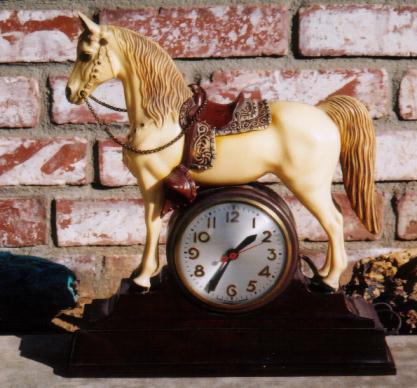 Possibly the most interesting and most controversial topic on collecting Hartland Horse and Riders revolves around the clocks Hartland Plastics made for Mastercrafters Clock and Radio. Numerous “murky” stories have been told on how and when everything happened. After several years of research, a small group of Hartland and Breyer collectors now believe to have cleaned up all the mess.
Possibly the most interesting and most controversial topic on collecting Hartland Horse and Riders revolves around the clocks Hartland Plastics made for Mastercrafters Clock and Radio. Numerous “murky” stories have been told on how and when everything happened. After several years of research, a small group of Hartland and Breyer collectors now believe to have cleaned up all the mess.
![]()
Actually, the story line is a simple one.
Here’s my version:
Sometime in 1949, or possibly a little before, Hartland Plastics, Inc. contracted with Mastercrafters Clock and Radio for a production run of “parts” for a distinctive horse clock. The horse straddled over a Sessions clock, as seen above. This configuration is commonly called the “Horse Over the Clock”, or HOC. Hartland’s parts included the decorative mantle base, a horse designed to face left on the base, and a saddle. Some Hartland collectors call this the “Victor” horse. Over the production run, Hartland produced the bases in walnut and alabaster colors and the horse in white, cream, and sorrel. The saddles were molded in a “short seat style” (not made for a rider) and generally had a “whitewash” finish over brown plastic. While the horse and saddle are not marked, the underside of most bases in either color have a faint Diamond I imprint, indicating it was a Hartland product. That imprint was used on other Hartland pieces and can be confirmed in a printed document.
Details of exactly what went wrong between Hartland and Mastercrafters are not currently known, but we can be fairly sure Hartland supplied more bases to Mastercrafters than horses and saddles to go on them. In late 1949 or early 1950, Mastercrafters approached Breyer to create a horse and saddle to mount on their existing stock of bases. Breyer needed to create a horse that looked very “similar” to the image shown in MC’s advertising—and it would have needed to fit the hoof locations on the Hartland base. At some point, the inventory of bases would have run out and Breyer was commissioned to create the new base and clock housing for what collectors refer to as the “Horse Beside the Clock” or HBC.There is a possibility Hartland produced and sold their “Victor” horse as an individual element before and possibly during their deal with Mastercrafters.
Hartland used their horse molds to sell individual stand alone horses. Sometime in late 1953, they began producing riders to accompany a later style large horse with the mane on the right and a separate glued on tail.
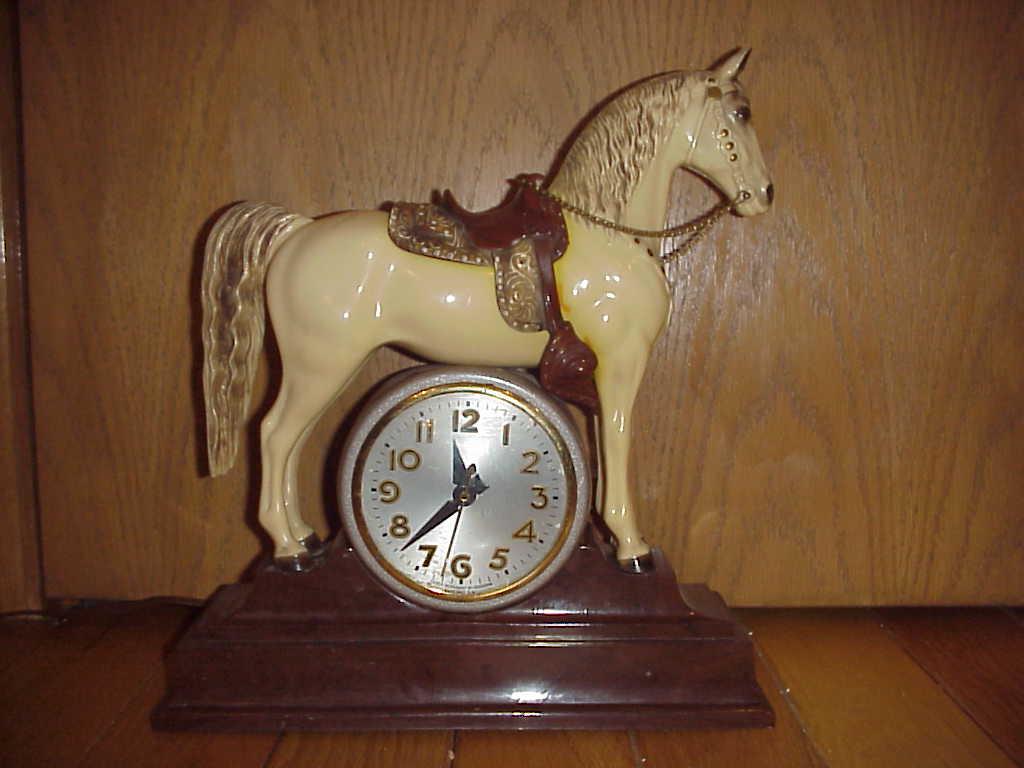
Until Recently, collectors were told the horse with the mane on the left was a Breyer horse, while the horses with the mane on the right were Hartlands. As of early 2005, it appears this was still the prevailing train of thought, especially within the Breyer community. Our research concludes the story line has been incorrect all along and will probably take a few years to filter throughout both groups of collectors.
The rest of this page explains how our little research group came to make those conclusions, plus explain how to tell a Breyer Western Horse from a Hartland Large Earliest Victor Horse.
Supporting Documentation and Clues
It has taken several years to locate solid information about this topic. Most of what we have had to work with in the past has been very sketchy…often recalled and passed on by people that didn’t actually witness the steps.
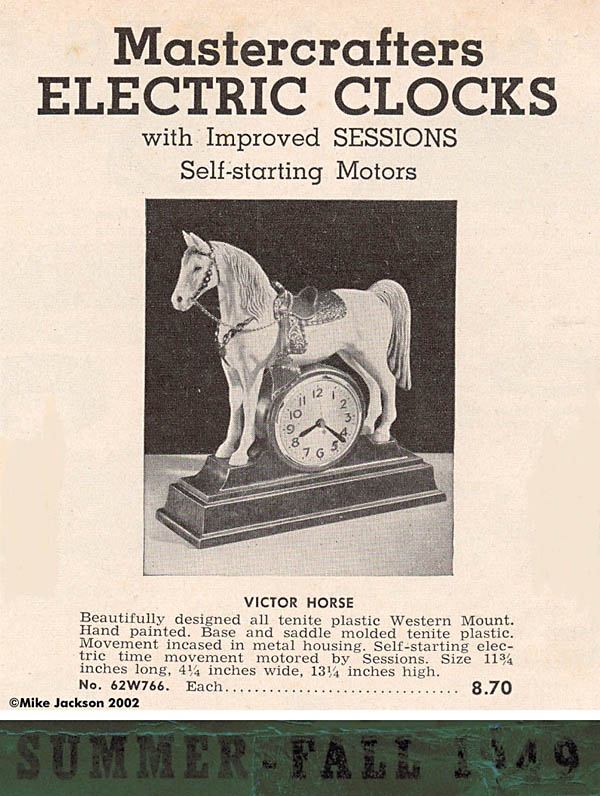
Victor Horse:
This is the first solid piece of documentation I was able to find back in February of 2002. It is from a Summer/Fall 1949 “counter book”, sometimes found in jewelry stores of the time. When I first found the ad, most Breyer collectors were perplexed knowing Breyer didn’t begin making horses until 1950. The base shown is a walnut base with a light colored horse with dark shading in the mane and tail. A similar ad appeared in Bennett Brother, Inc.’s 1950 Blue Book of Quality Merchandise catalog, however the manufacturer’s suggested retail price was listed as $14.95
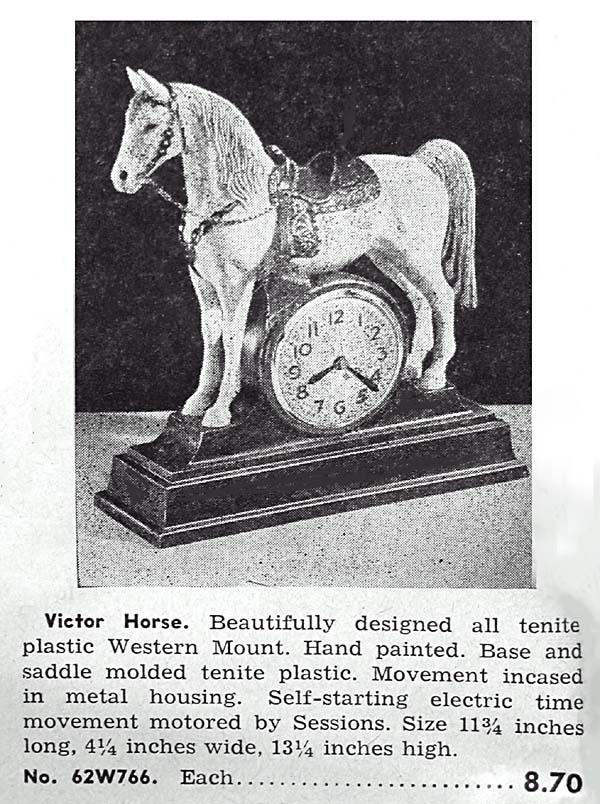
This ad appeared in the same counter book the following year. The copy is basically the same, however they moved the larger text down and made it smaller. The ads appeared in the 1949 and 1950 editions of this counter book, but was not in the 1948 or 1951 editions.
(I had help finding these ads from a catalog dealer, however he would not tell me the name of the catalog. He was still trying to find additional years and did not want to bid against me. Still, I trust the source.)
Based on the Victor Horse ads we were able to positively state that the clock was available in 1949 and at least part of 1950.
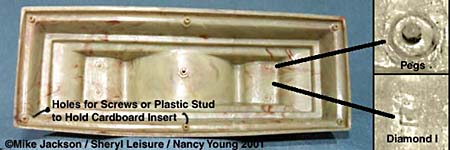
The ads confused our little study group. It appeared to us at the time that Breyer horses were on the bases. Interestingly, Sheryl Leisure noticed the Diamond I imprint on the underside of a “Hartland” style clock base. Then, to our amazement, Sande Schneider took the cover off her “Breyer” style base to discover it also had the Diamond I mold mark! Others checked the underside of their bases. All the bases we were able to get inspected at that time did have the imprinted mold marking. How and why would a Breyer horse be on a Hartland base?…and who made the saddles?
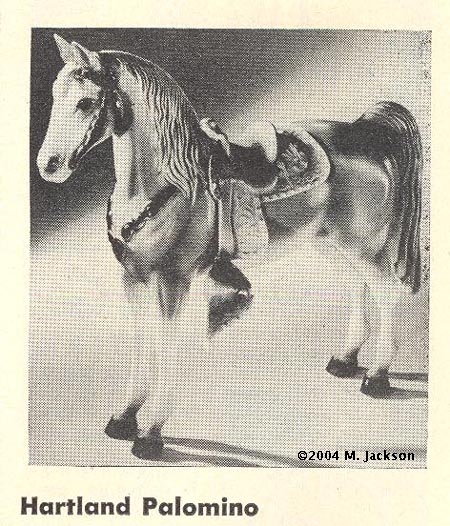
The Missing Link finally appeared! The close up of the ad below appeared in Novelties and Toys in June of 1950. As the section states, this was Hartland’s offering for “New Toys on Parade”. Again, we were offered a knuckle ball. The horse shown in the ad had the mane on the left!
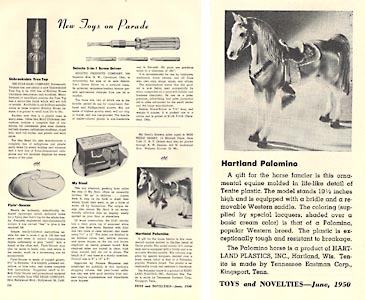
It took us a while to understand what we were seeing. Surely, Hartland wouldn’t use a photo of a Breyer horse in their own ad? Nancy Young identified it as one of the horses with the diamond conchos and distinctive tail. That horse matched the horse in the Victor Clock ads. Pieces of the puzzle started making sense.
It became clear the horse was a Hartland piece and it had been standing on a Hartland base all along. Later it became apparent the saddle was also a Hartland piece when compared to other positively identified Hartland saddles.
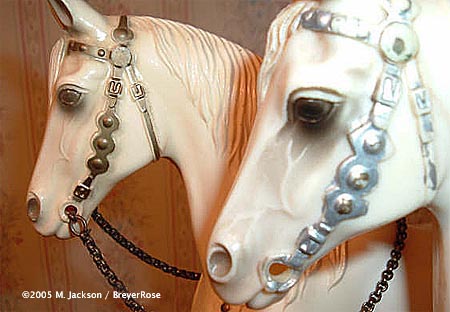
The key to identifying Hartland and Breyer horses can be seen in the photo above. Notice the shape of the conchos on the bridles of the two horses above. Nancy Young, the quintessential Breyer expert, labels the style on the right as “diamond conchos”. Well, they aren’t exactly perfect diamonds, but they aren’t round. A Breyer Western Horse is shown on the left. We are now confident that all large horses with the diamond conchos were actually Hartland pieces, regardless of the side the mane is on! (There may be a few knockoff versions out there that are similar).
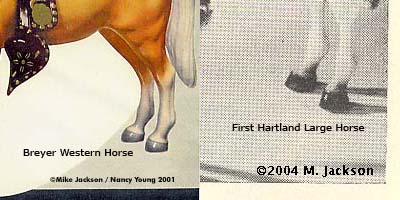
Breyer and Hartland Hooves: In 2004 Kaia Denham pointed out another important distinction in the two company’s horses. Breyer hooves are slightly rounded across the front of the hooves, while Hartland hooves are almost perfectly straight.
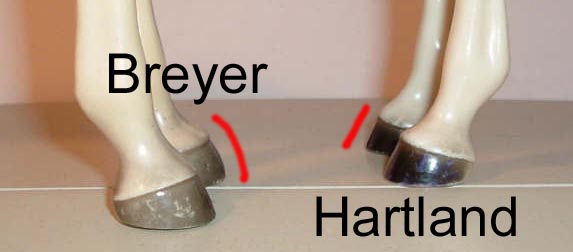
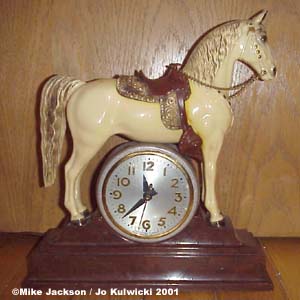 The last loose end we had to explain was the occasional occurrence of the new style “Hartland” horse on the clock base. The ad above probably supplies a few clues. By press time of 1950, Hartland was announcing their intentions of entering the toy market. While we may never know all the reasons for the new style horse, I suspect they were preparing for the upcoming demand on the mold.
The last loose end we had to explain was the occasional occurrence of the new style “Hartland” horse on the clock base. The ad above probably supplies a few clues. By press time of 1950, Hartland was announcing their intentions of entering the toy market. While we may never know all the reasons for the new style horse, I suspect they were preparing for the upcoming demand on the mold.
Mastercrafters went to Breyer Animal Creations to fill existing orders of Horse Over the Clocks, then developed a new “Horse Beside the Clock”using the same horse. As seen above, it had perfectly round conchos, a base, and a saddle for their offering. Using limited documentation, I suggest Hartland’s relations with Mastercrafters all happened in early 1949 to early 1950. Hartland’s second horse was apparently in production at some point near the end of the clock production run. At least a few of the new style horses made it onto the bases. No one really knows if any of the later style clocks were actually sold through Mastercrafters, or if they were just remnants and prototypes kept by Hartland officials and employees. Only a few have survived.
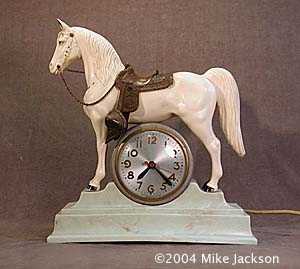
The Alabaster, or light marble base is another variation. It was also produced by Hartland Plastics for Mastercrafters Clock and Radio. So far, I have not been able to find an ad showing this configuration, but it has to exist somewhere. The horse shown in the photo on the right is what Nancy Young calls the “sorrel version”. Many of the horses in this color scheme have turned to a “bile” green. The left image is white horse on the same style base.
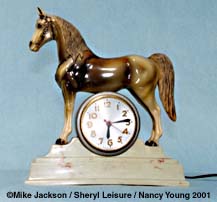 Nancy Young, author of Breyer Molds and Models, also uses this horse to help confirm this is a Hartland offering and not a Breyer horse…..”And consider, too, the fact that Hartland sorrel color (painted on other Hartland molds) is known to turn green. Sheryl owns an example or two and told me that this is a known tragedy among Hartlands. Breyer sorrels and palominos, on the other hand, retain their lovely realistic colors to this day (though their plastic can yellow, of course). Breyers don’t turn green. So the very greenness of the diamond-conchos greenies implicates them as Hartlands.”
Nancy Young, author of Breyer Molds and Models, also uses this horse to help confirm this is a Hartland offering and not a Breyer horse…..”And consider, too, the fact that Hartland sorrel color (painted on other Hartland molds) is known to turn green. Sheryl owns an example or two and told me that this is a known tragedy among Hartlands. Breyer sorrels and palominos, on the other hand, retain their lovely realistic colors to this day (though their plastic can yellow, of course). Breyers don’t turn green. So the very greenness of the diamond-conchos greenies implicates them as Hartlands.”
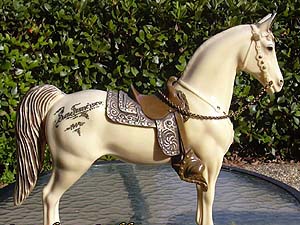
The San Francisco Horse:
In July of 2004, Shanna Hughes notified me of a horse she owned. The horse is of the early style, with off white plastic and brown stained mane and tail, including the diamond conchos. The hooves show no evidence of having holes drilled in it for pegs or screws from being fastened to a base. Photos couresty Shanna Hughes:
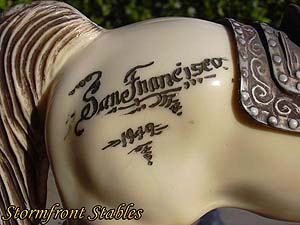 On the flank of the horse, someone had burned in San Francisco 1949. It looks professionally done in a calligraphic style.
On the flank of the horse, someone had burned in San Francisco 1949. It looks professionally done in a calligraphic style.
Assuming the date is correct, the horse at least suggests Hartland was selling the freestanding horse either before or during their Mastercrafters Clocks. When I say “before”, I introduce the option that Hartland may have already had the horse manufactured and didn’t know how to market it or get it on the streets. Possibly Hartland contacted Mastercrafters to see if they were interested in making a clock. This might explain a few other mini-mysteries. Hartland may have discovered they could sell the horse easily enough on their own, and make more money in the process, than just getting a small slice of the pie with Mastercrafters. The next logical progression would be an ad in a toy catalog.
While I might have a bit of experience holding a lot of the Horse and Rider sets, my hands-on experience with the clocks has been extremely limited. For many years, I was only trying to find one of the clocks with the horse facing right, with the mane on the right. The rest were Breyers. Right? So, when it comes to a few related details, I must glean information from others with more experience and more examples to examine.Sande Schneider has kept me on track throughout all this, so I will fall back on her expertise on the saddles. Sande sent this information to me in a recent E-Mail:
“In my observations, I have determined that old Breyer saddles always have the donut-hole style rivets/grommets attaching the cinch to the saddle. Earlier saddles have the grommet high up on the fender, and later ones have the grommet noticeably lower on the fender. Works that way with Breyer’s Western Pony and Prancer saddles too. Both of those size saddles with cinches have snap-on cinches.Whereas some, only some, early Hartland saddles have cinches. Those cinches are attached to their saddles with a nail-head style grommet, and those cinches fasten with slip-thru buckles, NOT snaps. From what I’ve seen, original saddles from Hartland horses *over* clocks were also brown with whitewashed skirting. Some of those saddles were cinchless and others had the buckle-on cinches. I’m not sure which style came first, but I’ve had only two of the buckle-on ones, and only two of the cinchless ones. But, then I can only remember ever owning five Western Horses that were the Hartland ones with mane on the left side. Two of those were still over clocks and the other three were free-standing, but may have been over-clocks at one time.”
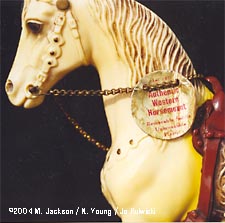 Once again, I will have to rely on other people for this one, though I do have a few examples to photograph. In the early horses, there were two basic types.
Once again, I will have to rely on other people for this one, though I do have a few examples to photograph. In the early horses, there were two basic types.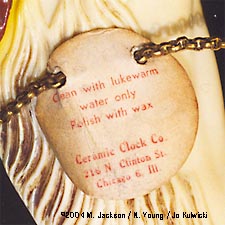
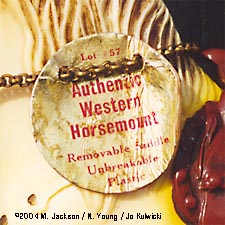
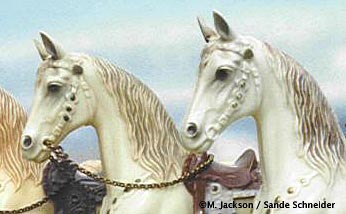 The horses in the photo on the right are owned by Sande Schneider. The horse on the right lacks the drilled out holes for any sort of reins. She points out the same scenario in the 1950 toy ad. She reports seeing another gray one at a show.
The horses in the photo on the right are owned by Sande Schneider. The horse on the right lacks the drilled out holes for any sort of reins. She points out the same scenario in the 1950 toy ad. She reports seeing another gray one at a show. Even though the reins with the horse in the back are on a Breyer horse, the photo above illustrates the other style connector often associated with the early horses. Of the four examples I have here right now, three have clasps. The “diamond” concho is clearly visible at the top of the closest bridle. It is a Hartland piece, while the distant version shows the round conchos.
Even though the reins with the horse in the back are on a Breyer horse, the photo above illustrates the other style connector often associated with the early horses. Of the four examples I have here right now, three have clasps. The “diamond” concho is clearly visible at the top of the closest bridle. It is a Hartland piece, while the distant version shows the round conchos.
The Third Large Horse:
In late 1953, Hartland began producing a new large rider for the large horse. The new toy campaign maintained momentum throughout 1954. With the new rider, Hartland created a long seat saddle and later a new horse. Like their second horse, the mane was created on the right side. To further distinguish it from the horse being produced by Breyer, Hartland removed the split in the mane and removed the round portion of the round conchos on top edge of the martingale. Hartland continued to use their second and third horse mold throughout the production of their 900 series Horse and Riders.
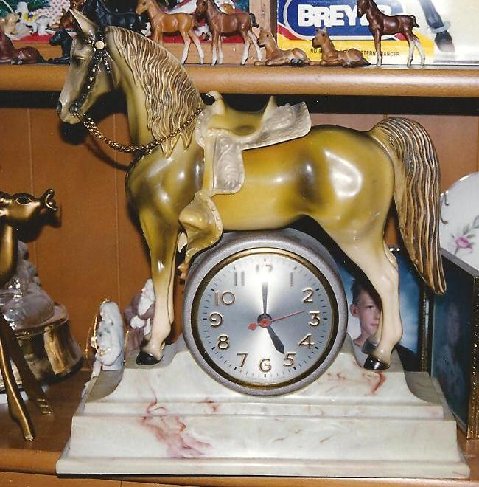
Sue Rowe’s Clock photographed by Sande Schneider in 2000 (or so) which has a Hartland “Victor” horse.
The Horse over the Clock: (2011 additions)
You might still find sites showing a large horse with “diamond conchos” straddled over a Sessions clock being attributed to Breyer, but I think it is time to state they are wrong. However, there appears a wrinkle in the story line. There are a few actual Breyer (Western Horses) mounted over a Sessions clock and attached to a base identical to the Hartland version of the base. (Round Conchos) Most of the few that have been reported are missing the Diamond I imprint on the underside of the base. A couple are reported to still have at least part of the old imprint. I have one base like this and it doesn’t appear to me the imprint was ground off after it was molded.
While no one will probably know exactly how all this played out, it seems logical to me that Hartland returned their base mold to Mastercrafters after their run, keeping their version of the Victor horse. Mastercrafters would have supplied the old base to Breyer, where their sculptors created a new version of the horse to go over the old base. I find this revelation noteworthy, as this would have required the sculptor to create a horse to fit the same mounting points and have the same clearance under the belly of the horse. Also, the new Breyer horse would have been required to look very close to any ads or flyers Mastercrafters would have been using for the piece.
More than likely, someone in the assembly plant noticed the remnants of the old Hartland Diamond I imprint on the underside of the base. Breyer would have filled the imprint on the original mold and continued production.
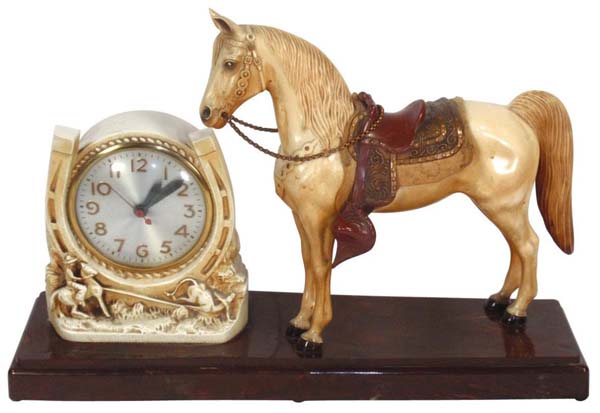
When Breyer created their new version of the clock for MasterCrafters, they made a base for the horse to stand off to the right side of the clock, but would have used the same horse mold.
With this recent revelation, it is now clear why Breyer’s Western Horse is so similar to the Hartland “Victor” horse. It appears the Breyer HOCs had both walnut brown and light alabaster bases—attached in a variety of different ways. These kinds of details are always perplexing and essentially impossible to explain with so few specimens to work with at this date.
The timeline here is of some importance, too. Consider the fact we know Hartland was making the MC clocks in 1949 and apparently stopped sometime shortly afterwards. The Novelties and Toys ad appeared in June of 1950, indicating Hartland was beginning to sell their horse as a toy. Breyer’s documentation states they began in 1950 making horses for the Mastercrafters clocks. The first Breyer clocks now appear to have been produced to fill orders for the “Horse Over the Clock” style. And, later Breyer produced the “Horse Beside the Clock” for Mastercrafters Clock and Radio. I’ve asked Breyer collectors about dates when Breyer finished their run of MC clocks, but so far, I haven’t heard any confirmed dates. We don’t know if Breyer had to wait for their contract to expire with MC to begin selling their horse as a toy or collectible, but it would seem to be the case. That period of time, however long it might have been, would have given Hartland a bit of a head start in the business of collectible plastic horses.
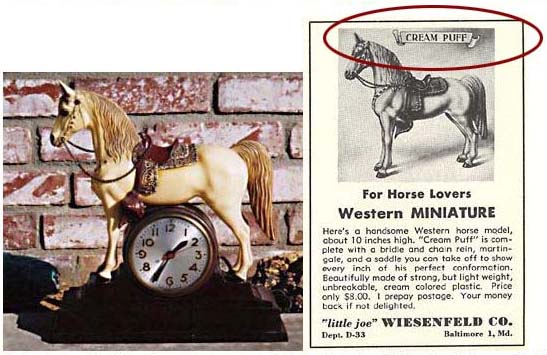
“Victor” style horses can be found in a variety of colors, including the version many people call “Cream Puff”. No known Hartland documentation exists giving that horse the name, however a couple of ads for Little Joe Weisenfeld Co. This ad appeared in Western Horseman magazine in November of 1950 and again in November of 1951. These are Hartland horses!
Apparently, the name for this colorization became commonly accepted. Some Breyer horses were later labeled as a Cream Puff color. Actually, that makes a lot of sense now, as most collectors thought the horse shown in the images above were all Breyers until the 2004 release of our findings. Even so, both companies sold their own version of “Black Beauty”.
Besides the Cream Puff style Victor horses found as both stand-alone and on Horse Over the Clocks, other color of the Victor horse were produced. Some are calling the “Bile” green a specific color horse, but I am still convinced that Nancy Young was correct when she identified them as sorrels that have faded over time to this color. Additionally, there may have been a dark charcoal version of the horse—which has also faded to some darker flavor of “Bile” colorization. Once the saddle is removed from many of the off colored horses, remnants of the original paint color can usually be seen.
The original 1950 ad from Novelties and Toys described the horse as a Palomino, but that might have been misnamed. Normally, palominos have the golden body and white tail, blaze, mane and stockings. The mane and tail in many of the ad seems to indicate the horse had darker colors in them!
Going back to the timeline again, it appears Hartland was selling freestanding, collectible toy horses from the middle of 1950 through 1953 when they started adding a larger cowboy rider. The “Champ” style version of the horse was created sometime before the end of 1951. (I’m basing that dating on the fact that a photo — as published on page 122 of Gail Fitch’s Hartland Horsemen {Schiffer Publishing, © 1999} — identifies one of its subject as being Ed Walters, who passed away in December of 1951.) So, Hartland had at least two molds running during that three or four year span. The early one faced left and the later one faced right. During that time, Hartland produced a huge variety of colors of freestanding horses. More variations show up monthly. Past 1953, Hartland continued to sell a few freestanding horses, but their emphasis switched to horse and rider sets.
Both Hartland and Breyer had “toy” beginnings that criss-crossed through Mastercrafters Clock and Radio, but after completing their contracts, went their own directions. After all the research, I am fairly confident in saying Hartland was first at both the clocks and at the concept of a toy collectible. With limited detailed documentation, I still believe Breyer was first to introduce a rider, an opinion offered to me and shaped by Nancy Young.
Fine details of this period were always cloudy. Some printed reports of the events were either false, incomplete, or misleading. After speaking with Bernard Ellman, president of Mastercrafters, he made it perfectly clear that none of the Hartland management (including Charles Caestecker) or owners ever had any ownership or parternership with their company. This contradicts a couple of the stories I’ve read. In phone conversations, I asked Paul Champion, Ed Hulbert, Rita McGuire (Robert McGuire’s wife) about their recollections of the early events, but neither could relay any solid, first hand knowledge. Some of their early reports were apparently written as fact without proper follow-up and verification with ads and documents. Unfortunately, the books and articles containing the old information are still on people’s shelves and are still being purchased by collectors.
2014 Additions:
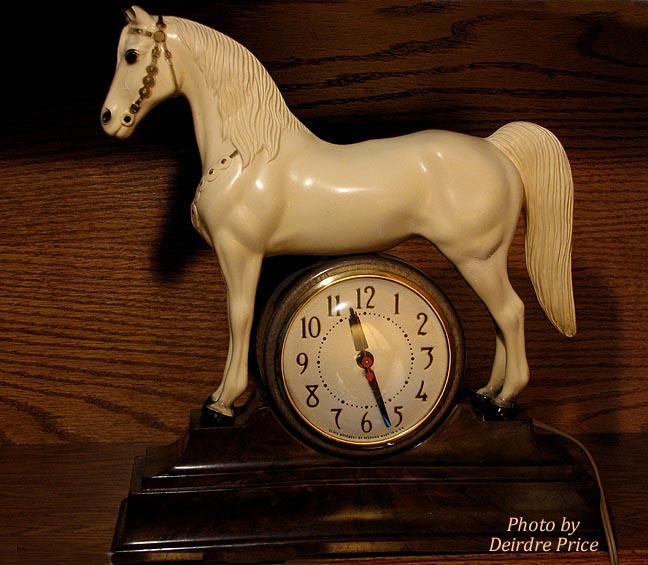
In 2011, a couple of collectors identified a few versions of the Horse Over the Clock (HOC) with a true Breyer horse attached. By “true Breyer”, I am referring to the style with the round conchos matching the horse Breyer is known to have produced for the Horse Beside the Clock (HBC). A few were reported being attached to a Hartland style HOC base. Some had faint or non-visible Hartland Diamond I imprints. The information was interesting at the time, but I only mentioned it.
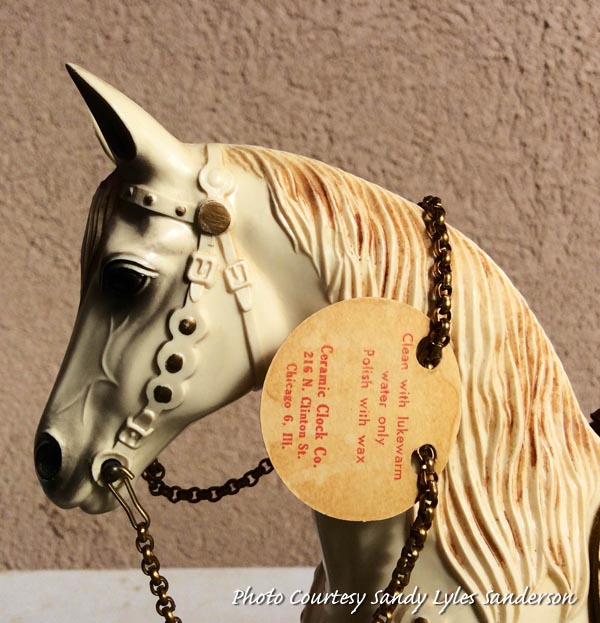
In 2014, Sandy Lyles Sanderson came up with the same style Breyer horse with a clock style tag still attached to the ring style reins. The tag is identical to the one shown on a Hartland style horse earlier on this page.
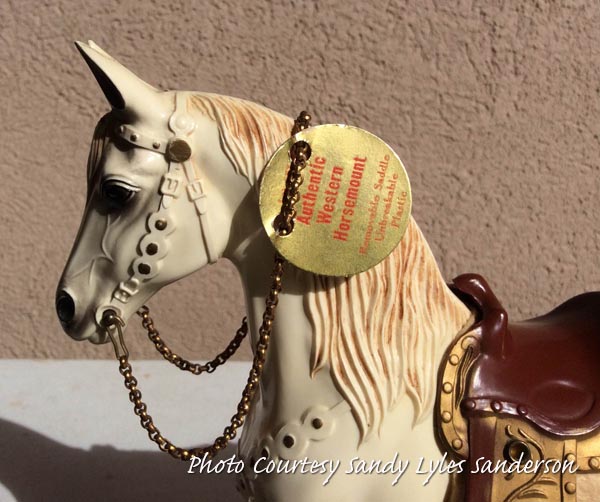
Interestingly, there are no indications the horse had ever been attached to a base. There is no glue residue or holes of any kind. The small indentions seen in the bottom of the hooves (below) might be an indication of a removed peg, or possibly a target location for drill holes. For now, I will just point it out in case they ever become an important clue.
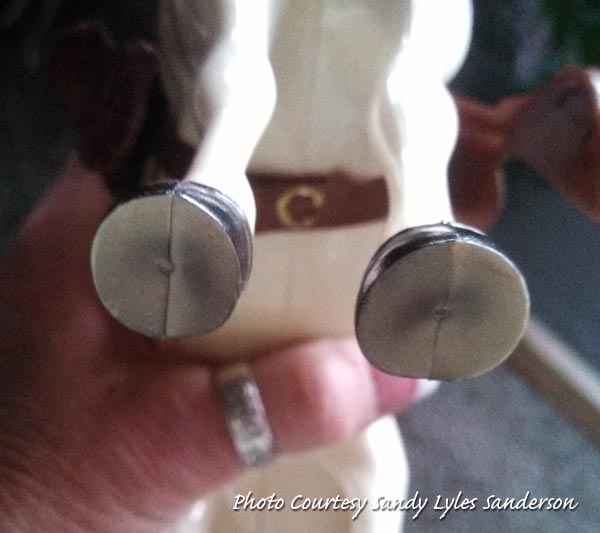
After seeing Sandy’s Breyer horse with the clock tag and mulling over the Breyer horse on a Hartland base, I felt it was time to gather the Clock Horse group for a 2014 addition to this page. While neither had immediate implications when viewed separately, when paired for evaluation, I think they shed considerable light on the topic.
Minor details may never be known, but it appears Hartland supplied Mastercrafters Clock and Radio with more bases than horses.

The bases were cast in walnut brown and alabaster. Hartland apparently supplied Victor style horses in cream, white, and sorrel colors along with the accompanying saddles.
 The only ad I ever turned up was the Victor horse over a walnut base, however quite a few examples exist of the various color schemes. Considering how many Mastercrafter ads I turned up from that time period, I always found the lack of Mastercrafters ads showing any version of horse clock surprising. There are very few (if any) known ads showing the later Breyer “Horse Beside the Clock” version.
The only ad I ever turned up was the Victor horse over a walnut base, however quite a few examples exist of the various color schemes. Considering how many Mastercrafter ads I turned up from that time period, I always found the lack of Mastercrafters ads showing any version of horse clock surprising. There are very few (if any) known ads showing the later Breyer “Horse Beside the Clock” version.
Whether Hartland supplied an assembled horse, saddle, and reins with the tag, or supplied individual parts that Mastercrafters assembled is not known, but also not of great importance as far as I can tell. There were at least two methods of fastening the horse to the base—screws or pegs. This point might someday help determine the order of production or be a clue to another piece of the puzzle, but for now, I don’t think it affects the story line to any degree.
What IS important is the apparent shortage of horses to go on the bases. I believe this is a strong indication Mastercrafters did a fair amount of the assembly at their factory. That would include attaching the horse to the base, the clock housing and clock mechanism to the base, and the cardboard panel on the underside prior to packaging and shipping.
After all the years and all the controversy, this actually turns out to be an amazingly simple story line.

No one knows the exact reason Hartland stopped making pieces for Mastercrafters, but that’s where Breyer came into the picture. If Hartland refused to supply the horses necessary to complete the production run of the HOC, Breyer would have been needed to create a horse that looked very similar to the image shown in MC’s advertising—and it would have needed to fit the hoof locations on the Hartland base. At some point, the inventory of bases would have run out and Breyer would have been commissioned to create the new base and clock housing.
Loose ends:
I had three or four of the Hartland HOC bases and inspected them personally after removing the cardboard cover. The Diamond I imprint was not overly apparent on any of them. At this point I could speculate that the people reporting only a faint or almost non-existent imprint may be a matter of visibility. There might have also been some wear on the fine details on the mold towards the end of the production.
Sandy’s pristine horse with the tag may have been an overrun, a salesman’s sample, or a display piece at Breyer’s factory. If, for example, it was simply a left over piece at either the Breyer factory or the Mastercrafters factory, it could have been taken home by an employee once the project was finished. I’ve heard of numerous stories of that happening at the Hartland factory—including some oddball color schemes that were never put into production.
Some of this story line might never be officially confirmed, but when the big parts are put into view, the story line is very linear. For example, if Hartland had continued to supply the horses, there would have never been a need for a Breyer style horse to match the hoof placement—nor would the Breyer horse need to match the Hartland Victor style horse as closely as it did. Breyer changed the concho shape to round and they added some curve to the front of the hooves. The plastic saddles supplied with the Breyer style HOC horses were similar, but slightly different. Paint jobs on the saddles differed slightly, too, but a casual viewer would never catch them. No one knows the size of Hartland’s run, nor the amount of pieces Breyer might have needed to supply to finish the project.
My last comments: Mastercrafters Clock and Radio was prolific at producing a variety of clocks during this time. Many were colorful and creative. There are numerous color ads in magazines of the day, yet finding images with the HOC in them has been almost impossible to find. I have no idea why? If we could turn back the page about 65 years, Hartland could have saved us a lot of hassles if they had put a Diamond I on the inside leg of the first Victor horse and the underside of the saddle!
2014 Challenge!
I understand there are a few die-hard Breyer collectors still holding on to the notion that Breyer actually created the first horse on the Mastercrafter base (Victor: With the Diamond Conchos). I’d love to hear them explain the sequences and events in a way that could convince me it happened their way! Here are a few key issues:
- The Diamond I Brand on the bases (a Hartland Imprint)
- The 1949 ad—Breyer’s own documentation says they started in 1950.
- Hartland saddle on the early horse and base
- June 1950 Novelties & Toys Hartland ad with a Victor style horse.
This page has been written and re-written several times since my first attempt in 2000. The current version will probably change some, too, but right now I feel very confident we are pretty close to the truth. When the June, 1950 Novelties and Toys announcement appeared, the entire story line had to be updated and modified. While waiting for the “fallout” to settle, I created a post on my bulletin board about the new finds. Notable collectors such as Nancy Young, Sande Schneider, and others added information to support the new story line, along with numerous additional photos and ads.
The 2000-2005 Clock Research Group:
As mentioned earlier, the research on this topic has been ongoing since 2000. Of course, research continues as I write this page again. I’ve had a lot of help from numerous dedicated Hartland and Breyer collectors. All have been eager to help. Thanks to all!
The research group included:
Mike Jackson, Denise Deen, Phil Duncan, Jo Kulwicki, Hartland Collectibles, LLC, George C. Jones, Sheryl Leisure, Bruce Schwartz, Sande Schneider, Joy Sheesley, Heather Wells, Kaia Denham, Nancy Young, and a long list of others that have helped with photos and leads.
The 2011 Clock Research Group:
Mike Jackson, Sande Schneider, Kaia Denham, Dede Price, & Susan Tank
The 2014 Clock Research Group:
Mike Jackson, Sande Schneider, Kaia Denham, Dede Price, Susan Tank, & Sandy Lyles Sanderson
![]()
In July of 2022, Darla and I made the tough decision to sell out in Jackson Hole and move to a new home in Colorado. With limited space, I sent my entire collection of Hartland sets and boxes to an auction company. I still have a nice group of original parts, and some religious sets and pieces but I don’t have any boxes available now.
When I sold many of the sets, I pulled off many of the original parts to sell in the future. I have a lot of saddles, hats and weapons…just need to dedicate the time to photograph and list the pieces I have.
While I probably “should” close this site, I have left some of the old Hartland History pages, such as the Champ and Mastercrafters Clocks pages available. The pages corrected information found in some of the available books.
MJ
Mike Jackson 3588 Gold Hill Dr. – Loveland, CO 80538
E-MAIL
All Images and text on this site copyright Mike R. Jackson 1998-2024
